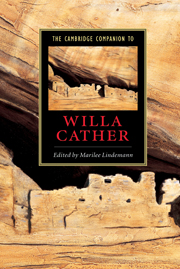Book contents
- Frontmatter
- Introduction
- Part I Contexts and critical issues
- Part II Studies of major works
- 10 Rereading My Ántonia
- 11 Fictions of possession in The Professor’s House
- 12 Catholic expansionism and the politics of depression in Death Comes for the Archbishop
- 13 Willa Cather and “the old story”
- Selected bibliography
- Index
12 - Catholic expansionism and the politics of depression in Death Comes for the Archbishop
from Part II - Studies of major works
Published online by Cambridge University Press: 28 May 2006
- Frontmatter
- Introduction
- Part I Contexts and critical issues
- Part II Studies of major works
- 10 Rereading My Ántonia
- 11 Fictions of possession in The Professor’s House
- 12 Catholic expansionism and the politics of depression in Death Comes for the Archbishop
- 13 Willa Cather and “the old story”
- Selected bibliography
- Index
Summary
Although writers choose from a variety of settings and circumstances for their novels, few writers venture into religious arenas in which they have little direct experience. Cather, whose family had been Baptists in Virginia, was no Catholic, although she joined the Episcopal Church on December 27, 1922, the same year when, she famously wrote in Not Under Forty, “the world broke in two.” When she began writing Death Comes for the Archbishop, she wanted to create a novel that reflected both her profound visual appreciation for the Southwest, which she had visited many times in her lifetime, and her respect for the contributions of the Catholic Church in that region and throughout America. That she admired the rich cultural and artistic traditions of the Church, as well as the devotion of its nineteenth-century missionary clergy, is evident in her novel. The work was inspired by a little known biography Cather discovered in 1925 while she was visiting Santa Fe, New Mexico. The Life of the Right Reverend Joseph P. Machebeuf, written by Father William Howlett and published in 1908, provided the writer with her novel's heroes: Jean Latour and Joseph Vaillant are closely based on the real-life Archbishop Lamy and his vicar-general Machebeuf.
- Type
- Chapter
- Information
- The Cambridge Companion to Willa Cather , pp. 191 - 204Publisher: Cambridge University PressPrint publication year: 2005



